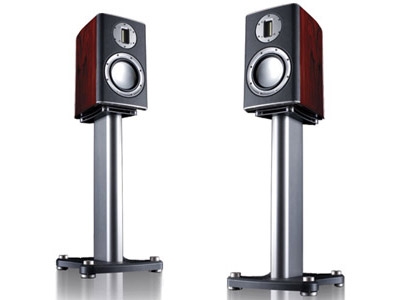Monitor Audio Platinum Series Home Theater Speaker System Page 3

The crystalline sound of the PL300 and PL100, combined with the almost perfectly matched voice of the PL350C, brought a new level of excitement to movie soundtracks. In the revered (if overplayed) tiger scene from Apocalypse Now, the bugs and birds - buzzing and cawing and circling all around me - sounded creepier than I could ever remember, thanks to the ribbon tweeters, and my anticipation of the tiger's attack became almost unbearable. Again, bad recordings proved extra-annoying; the ribbons did nothing to tame the harsh-sounding dialogue in the children's classic Matilda. But all of the other DVDs I played, from the frantic Live Free or Die Hard to the placid Planet Earth series, sounded pretty darn close to perfect, even without help from a subwoofer.
BOTTOM LINE
The Platinum Series proves that a little American influence can work aesthetic wonders. With the rich, enveloping sound of the best British speakers and the raw muscle needed to meet the demands of American-style home theater, this system is an all-around winner for any home that has the space for it.
 |
TEST BENCH
All three Monitor models have a similarly smooth response above 500 Hz. The PL300 tower exhibits a broad but shallow dip centered at 375 Hz, while the PL350C center shows a similar dip centered at 275 Hz. The PL350C has excellent off-axis perfor- mance for a center speaker, with only a slight treble rolloff above 10 kHz and a mild dip centered at 1.2 kHz when the mike is moved 15º or further off-axis. The PL300 and PL350C produce strong midbass output; at 10% distortion, both average around 100 dB in the range from 50 to 63 Hz. - B.B.
Frequency response (at 2 meters) PL300 40 Hz to 20 kHz ±2.5 dB PL350C 48 Hz to 20 kHz ±2.4 dB PL100 80 Hz to 20 kHz ±3.0 dB
Sensitivity (SPL at 1 meter with 2.8 volts of pink-noise input) PL300 90 dB PL350C 91 dB PL100 89 dB
Impedance (minimum/nominal) PL300 3.6/6 PL350C 3.6/6 PL100 4.0/7
Bass limits (lowest frequency and maximum SPL with limit of 10% distortion at 2 meters in a large room) PL300 32 Hz at 74 dB PL350C 36 Hz at 74 dB PL100 50 Hz at 75 dB PL300 90.5 dB average SPL from 32 to 63 Hz, 100.2 dB maximum SPL at 56 Hz, bandwidth uniformity 82% PL350C 93.3 dB average SPL from 36 to 63 Hz, 101.7 dB maximum SPL at 63 Hz, bandwidth uniformity 80%
All of the curves in the frequency-response graph are weighted to reflect how sound arrives at a listener's ears with normal speaker placement. All measurements were made at a full 2 meters. The PL300 was measured on the floor, because it will always be used that way. The PL350C and PL100 were measured on a 6-foot stand, which gives quasi-anechoic results to 200 Hz including full effects of cabinet diffraction and front panel reflections. Response of woofers and ports was close-miked, summed, and spliced to the quasi-anechoic response.
Frequency response of all speakers is impressively even; above 500 Hz, the average of 0°, 10°, and 20° responses is practically identical for all three speakers. The ribbon tweeter shows no roll-off even at the highest measured frequency of 20 kHz. Below 500 Hz, the PL300 tower exhibits a broad but shallow dip centered at 375 Hz, while the PL350C center shows a similar dip centered at 275 Hz. The PL350C has excellent off-axis performance for a center speaker, with only a mild dip centered at 1.2 kHz beginning when the mic was moved 15° or further off axis, and the expected slight treble roll-off above 10 kHz.
Both the PL300 and PL350C are muscular in the mid-bass region, delivering high output (98 to 101.7 dB) between 50 and 63 Hz at our measurement threshold of 10% THD at 2 meters in a large room. The distortion rises below 40 Hz, the PL300 reaching its useful limit at 32 Hz and 74.2 dB, the PL350C at 36 Hz and 74.4 dB. The PL100 has decent bass response for a bookshelf speaker, delivering 75 dB at 50 Hz.
Although the impedance of all three speakers runs a little bit low, the gentle phase response of the impedance curves and the speakers' slightly above-average sensitivity should make them easy for practically any decent amplifier or receiver to drive.













































